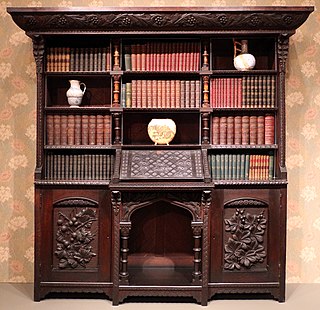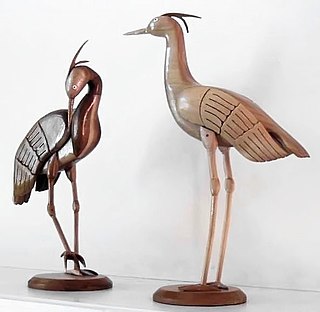
Woodworking is the activity or skill of making items from wood, and includes cabinet making, wood carving, joinery, carpentry, and woodturning.

Reinforced concrete (RC) (also called reinforced cement concrete or RCC) is a composite material in which concrete's relatively low tensile strength and ductility are counteracted by the inclusion of reinforcement having higher tensile strength or ductility. The reinforcement is usually, though not necessarily, steel reinforcing bars (rebar) and is usually embedded passively in the concrete before the concrete sets. Reinforcing schemes are generally designed to resist tensile stresses in particular regions of the concrete that might cause unacceptable cracking and/or structural failure. Modern reinforced concrete can contain varied reinforcing materials made of steel, polymers or alternate composite material in conjunction with rebar or not. Reinforced concrete may also be permanently stressed, so as to improve the behaviour of the final structure under working loads. In the United States, the most common methods of doing this are known as pre-tensioning and post-tensioning.

Terrazzo is a composite material, poured in place or precast, which is used for floor and wall treatments. It consists of chips of marble, quartz, granite, glass, or other suitable material, poured with a cementitious binder, polymeric, or a combination of both. Metal strips often divide sections, or changes in color or material in a pattern. Additional chips may be sprinkled atop the mix before it sets. After it is cured it is ground and polished smooth or otherwise finished to produce a uniformly textured surface.

A road surface or pavement is the durable surface material laid down on an area intended to sustain vehicular or foot traffic, such as a road or walkway. In the past, gravel road surfaces, cobblestone and granite setts were extensively used, but these surfaces have mostly been replaced by asphalt or concrete laid on a compacted base course. Road surfaces are frequently marked to guide traffic. Today, permeable paving methods are beginning to be used for low-impact roadways and walkways. Pavements are crucial to countries such as US and Canada, which heavily depend on road transportation. Therefore, research projects such as Long-Term Pavement Performance are launched to optimize the life-cycle of different road surfaces.

Building material is any material which is used for construction purposes. Many naturally occurring substances, such as clay, rocks, sand, and wood, even twigs and leaves, have been used to construct buildings. Apart from naturally occurring materials, many man-made products are in use, some more and some less synthetic. The manufacturing of building materials is an established industry in many countries and the use of these materials is typically segmented into specific specialty trades, such as carpentry, insulation, plumbing, and roofing work. They provide the make-up of habitats and structures including homes.
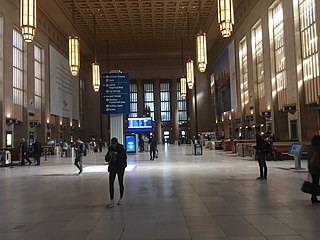
Interior design is the art and science of enhancing the interior of a building to achieve a healthier and more aesthetically pleasing environment for the people using the space. An interior designer is someone who plans, researches, coordinates, and manages such projects. Interior design is a multifaceted profession that includes conceptual development, space planning, site inspections, programming, research, communicating with the stakeholders of a project, construction management, and execution of the design.
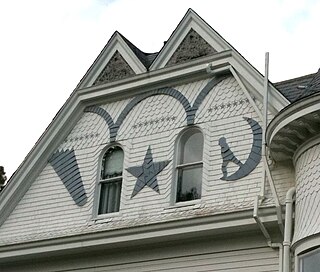
Siding or wall cladding is the protective material attached to the exterior side of a wall of a house or other building. Along with the roof, it forms the first line of defense against the elements, most importantly sun, rain/snow, heat and cold, thus creating a stable, more comfortable environment on the interior side. The siding material and style also can enhance or detract from the building's beauty. There is a wide and expanding variety of materials to side with, both natural and artificial, each with its own benefits and drawbacks. Masonry walls as such do not require siding, but any wall can be sided. Walls that are internally framed, whether with wood, or steel I-beams, however, must always be sided.
Ground-granulated blast-furnace slag is obtained by quenching molten iron slag from a blast furnace in water or steam, to produce a glassy, granular product that is then dried and ground into a fine powder.

Distressing in the decorative arts is the activity of making a piece of furniture or object appear aged and older, giving it a "weathered look", and there are many methods to produce an appearance of age and wear. Distressing is viewed as a refinishing technique although it is the opposite of finishing in a traditional sense. In distressing, the object's finish is intentionally destroyed or manipulated to look less than perfect, such as with sandpaper or paint stripper. For example, the artisan often removes some but not all of the paint, leaving proof of several layers of paint speckled over wood grain underneath. This becomes the "finished" piece.
Glass fiber reinforced concrete or GFRC is a type of fiber-reinforced concrete. The product is also known as glassfibre reinforced concrete or GRC in British English. Glass fiber concretes are mainly used in exterior building façade panels and as architectural precast concrete. Somewhat similar materials are fiber cement siding and cement boards.

Decorative concrete is the use of concrete as not simply a utilitarian medium for construction but as an aesthetic enhancement to a structure, while still serving its function as an integral part of the building itself such as floors, walls, driveways, and patios.

A volumetric concrete mixer is a concrete mixer mounted on a truck or trailer that contains separate compartments for sand, stone, cement and water. Materials are mixed on a job site to produce the exact amount of concrete needed.
Charles Hollis Jones is an American artist and furniture designer. He is known for his use of acrylic and lucite.

Danish Design is a style of functionalistic design and architecture that was developed in mid-20th century. Influenced by the German Bauhaus school, many Danish designers used the new industrial technologies, combined with ideas of simplicity and functionalism to design buildings, furniture and household objects, many of which have become iconic and are still in use and production. Prominent examples are the Egg chair, the PH lamps and the Sydney Opera House (Australia).
The idea of technology brokering is to span multiple, otherwise disconnected industries, to see how existing technologies could be used to create breakthrough innovations in other markets. Technology brokering requires companies to be strong in two areas. As Andrew Hargadon, technology brokering’s founder, summarized: "Firstly, the company must have the ability to bridge distant communities, usually when a company can move easily across a range of different markets they have a better view of how technologies can be used in new ways. Secondly, technology brokering involves creating new markets and industries from innovative combinations of existing technology. These two strengths are difficult to have simultaneously because the strong ties the companies have with customers and supplies in one industry prevent the company from moving easily into other markets and experimenting with new ideas." Yet, when a company is able to combine these two strengths it can result in being the first to experience technological advances.

Cement City Historic District is a historic district in Donora, Pennsylvania. The district includes 80 Prairie School concrete residences built in 1916-17. The homes served as housing for employees of the American Steel and Wire Company. Poured-in-place concrete houses had become popular in large-scale housing developments at the time, partly thanks to promotion by Thomas Edison; the homes built in Donora used a newly patented construction method from the Lambie Concrete House Corporation. Building the houses required a combined 10,000 barrels of Portland cement.
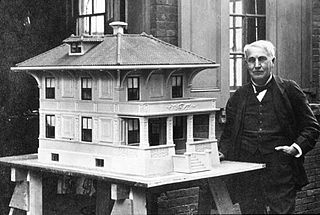
The Edison Portland Cement Company was a venture by Thomas Edison that helped to improve the Portland cement industry. Edison was developing an iron ore milling process and discovered a market in the sale of waste sand to cement manufacturers. He decided to set up his own cement company, founding it in New Village, New Jersey in 1899, and went on to supply the concrete for the construction of Yankee Stadium in 1922.

The Edison Ore-Milling Company was a venture by Thomas Edison that began in 1881. Edison introduced some significant technological developments to the iron ore milling industry but the company ultimately proved to be unprofitable. Towards the end of the company's life Edison realised the potential application of his technologies to the cement industry, and formed the Edison Portland Cement Company in 1899.

"A Fireproof House for $5000" was an article and house design by Frank Lloyd Wright which was published in the Ladies' Home Journal in April 1907. This was Wright's third and final publication in the journal following "A Home in a Prairie Town" and "A Small House with 'Lots of Room in It'" from February and July 1901, respectively. The drawings for the house were also included in Wright's 1910 Wasmuth Portfolio (Plate XIV).


